|
|
|
|
|
|
|
|
|
The Taff Vale Railway was another major user of somersault signals. On the TVR, the Rhymney Railway and the Barry Railway, their arms were painted with two white stripes [2.40 - 2.43]. Given that the arm rotated to a near vertical position, the resulting image of one white rectangle above the other provided drivers with a greater visual clue that the signal was 'off' [2.41 & 2.43].
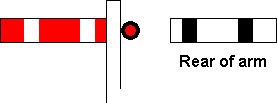 |
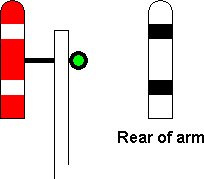 |
|
[2.40] 'Somersault' Stop Signal ('on').
Area: TVR / Rhy.R / Bar.R Usage: High Status: Historical |
[2.41] 'Somersault' Stop Signal ('off').
Area: TVR / Rhy.R / Bar.R Usage: High Status: Historical |
|---|---|
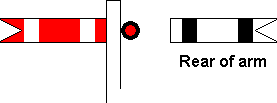 |
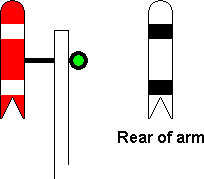 |
|
[2.42] 'Somersault' Distant Signal ('on').
Area: TVR / Rhy.R / Bar.R Usage: High Status: Historical |
[2.43] 'Somersault' Distant Signal ('off').
Area: TVR / Rhy.R / Bar.R Usage: High Status: Historical |
The Great Central Railway distinguished its signals applying to slow lines or loop lines by fitting rings to their arms, the rings being of a distinctive non-circular shape [2.44 - 2.47].
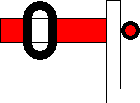 |
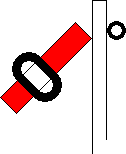 |
|
[2.44] Ringed Semaphore Stop Signal ('on').
Area: GCR Usage: High Status: Historical |
[2.45] Ringed Semaphore Stop Signal ('off').
Area: GCR Usage: High Status: Historical |
|---|---|
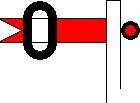 |
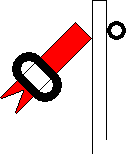 |
|
[2.46] Ringed Semaphore Distant Signal ('on').
Area: GCR Usage: High Status: Historical |
[2.47] Ringed Semaphore Distant Signal ('off').
Area: GCR Usage: High Status: Historical |
The North London Railway, which was closely linked to the LNWR, provided rings on the arms of signals applying to its 'No. 1' lines [2.48 - 2.51].
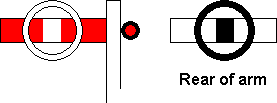 |
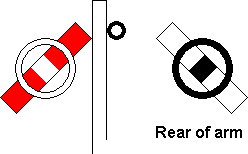 |
|
[2.48] Ringed Semaphore Stop Signal ('on').
Area: NLR Usage: High Status: Historical |
[2.49] Ringed Semaphore Stop Signal ('off').
Area: NLR Usage: High Status: Historical |
|---|---|
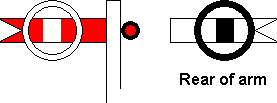 |
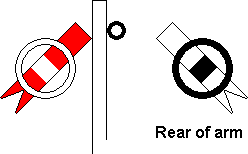 |
|
[2.50] Ringed Semaphore Distant Signal ('on').
Area: NLR Usage: High Status: Historical |
[2.51] Ringed Semaphore Distant Signal ('off').
Area: NLR Usage: High Status: Historical |
Uniquely, the NLR identified signals applying to movements to or from goods lines by the provision of a perpendicular bar on the arm [2.52 - 2.55]. There were some signal arms that carried both a ring and a bar [2.56 - 2.59].
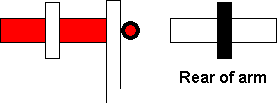 |
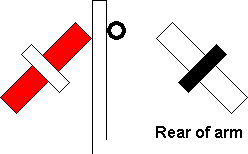 |
|
[2.52] Semaphore Stop Signal with Bar ('on').
Area: NLR Usage: Medium Status: Historical |
[2.53] Semaphore Stop Signal with Bar ('off').
Area: NLR Usage: Medium Status: Historical |
|---|---|
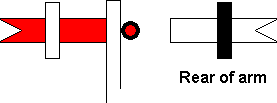 |
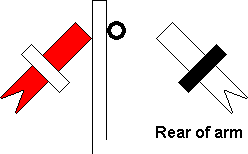 |
|
[2.54] Semaphore Distant Signal with Bar ('on').
Area: NLR Usage: Medium Status: Historical |
[2.55] Semaphore Distant Signal with Bar ('off').
Area: NLR Usage: Medium Status: Historical |
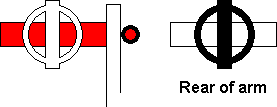 |
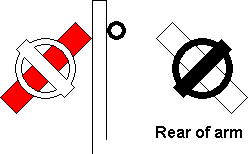 |
|
[2.56] Semaphore Stop Signal with Ring and Bar ('on').
Area: NLR Usage: Medium Status: Historical |
[2.57] Semaphore Stop Signal with Ring and Bar ('off').
Area: NLR Usage: Medium Status: Historical |
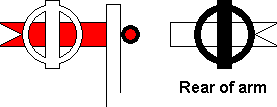 |
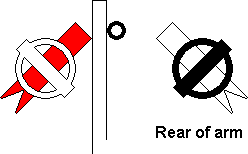 |
|
[2.58] Semaphore Distant Signal with Ring and Bar ('on').
Area: NLR Usage: Medium Status: Historical |
[2.59] Semaphore Distant Signal with Ring and Bar ('off').
Area: NLR Usage: Medium Status: Historical |
The permissive working of platform lines at a terminal station was first practised on the LB&SCR. This necessitated a means of indicating to drivers signalled into a platform road whether the line ahead was occupied or clear. John Saxby's idea, first implemented at London Bridge North signal box in 1878, was to provide a distant arm on the post of any stop signal that read into the platform roads. When the stop arm was cleared, the distant arm below remained at 'caution' (see [2.34]) if the platform road was already partially occupied; otherwise, it too was lowered (see [2.35]), indicating that the platform road was clear right up to the buffer stop. The Caledonian Railway adopted the same practice at important terminal stations, using a distant arm that was ringed and designated as a 'precaution signal'.
As the amount of white lights visible at night increased, it became more difficult for drivers to pick out which was their 'clear' signal light. Gradually, during the 1880s, some companies began to alter some of their signals to show a green light in the 'clear' position [2.60 - 2.63], as had been standard practice on the Great Northern Railway ever since the introduction of 'somersault' signals in 1877 (see [2.36 & 2.37]).
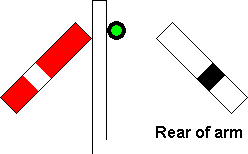 |
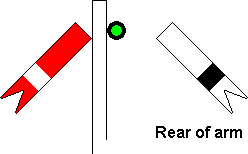 |
|
[2.60] Semaphore Stop Signal ('off').
Area: All Areas Usage: High Status: Obsolescent |
[2.61] Semaphore Distant Signal ('off').
Area: All Areas Usage: High Status: Historical |
|---|---|
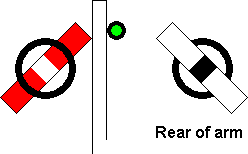 |
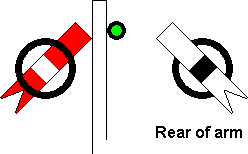 |
|
[2.62] Ringed Semaphore Stop Signal ('off').
Area: LNWR Usage: High Status: Historical |
[2.63] Ringed Semaphore Distant Signal ('off').
Area: LNWR Usage: High Status: Historical |
In 1887, the Great Northern Railway decided to abandon the use of distinguishing features on its goods line and slow line signals (see [2.38 & 2.39]), and set about removing the rings from their arms and replacing the purple lenses with green.
|
|
|